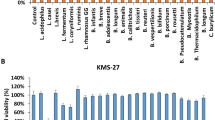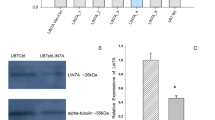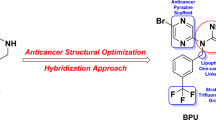Abstract
Aim:
To investigate the protective effect and underlying mechanisms of Bu-7, a flavonoid isolated from the leaves of Clausena lansium, against rotenone-induced injury in PC12 cells.
Methods:
The cell viability was evaluated using MTT assay. The cell apoptosis rate was analyzed using flow cytometry. JC-1 staining was used to detect the mitochondrial membrane potential (MMP). Western blotting analysis was used to determine the phosphorylation of c-Jun N-terminal kinase (JNK), p38 mitogen-activated protein kinase (p38), tumor protein 53 (p53), Bcl-2–associated X protein (Bax), B-cell lymphoma 2 (Bcl-2), and caspase 3.
Results:
Treatment of PC12 cells with rotenone (1–20 μmol/L) significantly reduced the cell viability in a concentration-dependent manner. Pretreatment with Bu-7 (0.1 and 10 μmol/L) prevented PC12 cells from rotenone injury, whereas Bu-7 (1 μmol/L) had no significant effect. Pretreatment with Bu-7 (0.1 and 10 μmol/L) decreased rotenone-induced apoptosis, attenuated rotenone-induced mitochondrial potential reduction and suppressed rotenone-induced protein phosphorylation and expression, whereas Bu-7 (1 μmol/L) did not cause similar effects. Bu-7 showed inverted bell-shaped dose-response relationship in all the effects.
Conclusion:
Bu-7 protects PC12 cells against rotenone injury, which may be attributed to MAP kinase cascade (JNK and p38) signaling pathway. Thus, Bu-7 may be a potential bioactive compound for the treatment of Parkinson's disease.
Similar content being viewed by others
Log in or create a free account to read this content
Gain free access to this article, as well as selected content from this journal and more on nature.com
or
References
Forno LS . Neuropathology of Parkinson's disease. J Neuropathol Exp Neurol 1996; 55: 259–72.
Betarbet R, Sherer TB, MacKenzie G, Garcia-Osuna M, Panov AV, Greenamyre JT . Chronic systemic pesticide exposure reproduces features of Parkinson's disease. Nat Neurosci 2000; 3: 1301–6.
Lees AJ, Hardy J, Revesz T . Parkinson's disease. Lancet 2009; 373: 2055–66.
Betarbet R, Sherer TB, Greenamyre JT . Animal models of Parkinson's disease. Bioessays 2002; 24: 308–18.
Uversky VN . Neurotoxicant-induced animal models of Parkinson's disease: understanding the role of rotenone, maneb and paraquat in neurodegeneration. Cell Tissue Res 2004; 318: 225–41.
Priyadarshi A, Khuder SA, Schaub EA, Priyadarshi SS . Environmental risk factors and Parkinson's disease: a metaanalysis. Environ Res 2001; 86: 122–7.
Vanacore N, Nappo A, Gentile M, Brustolin A, Palange S, Liberati A, et al. Evaluation of risk of Parkinson's disease in a cohort of licensed pesticide users. Neurol Sci 2002; 23: S119–20.
Chance B, Williams GR, Hollunger G . Inhibition of electron and energy transfer in mitochondria. I. Effects of Amytal, thiopental, rotenone, progesterone, and methylene glycol. J Biol Chem 1963; 238: 418–31.
Hartley A, Stone JM, Heron C, Cooper JM, Schapira AH . Complex I inhibitors induce dose-dependent apoptosis in PC12 cells: relevance to Parkinson's disease. J Neurochem 1994; 63: 1987–90.
Tapias V, Cannon JR, Greenamyre JT . Melatonin treatment potentiates neurodegeneration in a rat rotenone Parkinson's disease model. J Neurosci Res 2010; 88: 420–7.
Monti B, Gatta V, Piretti F, Raffaelli SS, Virgili M, Contestabile A . Valproic acid is neuroprotective in the rotenone rat model of Parkinson's disease: involvement of alpha-synuclein. Neurotox Res 2010; 17: 130–41.
Valverde G De Andrade D, Madureira de Oliveria D, Barreto G, Bertolino LA, Saraceno E, Capani F, et al. Effects of the extract of Anemopaegma mirandum (Catuaba) on Rotenone-induced apoptosis in human neuroblastomas SH-SY5Y cells. Brain Res 2008; 1198: 188–96.
Kim HJ, Park HJ, Park HK, Chung JH . Tranexamic acid protects against rotenone-induced apoptosis in human neuroblastoma SH-SY5Y cells. Toxicology 2009; 262: 171–4.
Liu GT, Li WX, Chen YY, Wei HL . Hepatoprotective action of nine constituents isolated from the leaves of Clausena lansium in mice. Drug Dev Res 1996; 39: 174–8.
Zhang J, Cheng Y, Zhang JT . Protective effect of (–)clausenamide against neurotoxicity induced by okadaic acid and beta-amyloid peptide25–35. Yao Xue Xue Bao 2007; 42: 935–42.
Qian W, Wang LN, Song M, Zheng XW, Hang TJ, Zhang ZX . Excretion of (–)-clausenamide in rats. Yao Xue Xue Bao 2006; 41: 789–92.
Zhao Q, Li C, Yang J, Zhang D . Chemical constituents of Clausena lansium. Zhongguo Zhong Yao Za Zhi 2010; 35: 997–1000.
Guzhva N, Luk'yanchikov M, Ushakov V, Sarkisov L . Flavonoids of Astragalus captiosus. Chem Nat Compd 1986; 22: 729.
Greene LA, Tischler AS . Establishment of a noradrenergic clonal line of rat adrenal pheochromocytoma cells which respond to nerve growth factor. Proc Natl Acad Sci U S A 1976; 73: 2424–8.
Nicoletti I, Migliorati G, Pagliacci MC, Grignani F, Riccardi C . A rapid and simple method for measuring thymocyte apoptosis by propidium iodide staining and flow cytometry. J Immunol Methods 1991; 139: 271–9.
Zhang ZT, Cao XB, Xiong N, Wang HC, Huang JS, Sun SG, et al. Morin exerts neuroprotective actions in Parkinson disease models in vitro and in vivo. Acta Pharmacol Sin 2010; 31: 900–6.
Lin CM, Lin RD, Chen ST, Lin YP, Chiu WT, Lin JW, et al. Neurocytoprotective effects of the bioactive constituents of Pueraria thomsonii in 6-hydroxydopamine (6-OHDA)-treated nerve growth factor (NGF)-differentiated PC12 cells. Phytochemistry 2010; 71: 2147–56.
Tan S, Sagara Y, Liu Y, Maher P, Schubert D . The regulation of reactive oxygen species production during programmed cell death. J Cell Biol 1998; 141: 1423–32.
Polster BM, Fiskum G . Mitochondrial mechanisms of neural cell apoptosis. J Neurochem 2004; 90: 1281–9.
Mattson MP . Apoptosis in neurodegenerative disorders. Nat Rev Mol Cell Biol 2000; 1: 120–9.
Waldmeier PC . Prospects for antiapoptotic drug therapy of neurodegenerative diseases. Prog Neuropsychopharmacol Biol Psychiatry 2003; 27: 303–21.
Reed JC . Apoptosis-based therapies. Nat Rev Drug Discov 2002; 1: 111–21.
Ferri KF, Kroemer G . Organelle-specific initiation of cell death pathways. Nat Cell Biol 2001; 3: E255–63.
Zimmermann KC, Bonzon C, Green DR . The machinery of programmed cell death. Pharmacol Ther 2001; 92: 57–70.
Pei W, Liou AK, Chen J . Two caspase-mediated apoptotic pathways induced by rotenone toxicity in cortical neuronal cells. FASEB J 2003; 17: 520–2.
Caughlan A, Newhouse K, Namgung U, Xia Z . Chlorpyrifos induces apoptosis in rat cortical neurons that is regulated by a balance between p38 and ERK/JNK MAP kinases. Toxicol Sci 2004; 78: 125–34.
Newhouse K, Hsuan SL, Chang SH, Cai B, Wang Y, Xia Z . Rotenone-induced apoptosis is mediated by p38 and JNK MAP kinases in human dopaminergic SH-SY5Y cells. Toxicol Sci 2004; 79: 137–46.
Junn E, Mouradian MM . Apoptotic signaling in dopamine-induced cell death: the role of oxidative stress, p38 mitogen-activated protein kinase, cytochrome c and caspases. J Neurochem 2001; 78: 374–83.
Davis RJ . Signal transduction by the JNK group of MAP kinases. Cell 2000; 103: 239–52.
Dai G, Huang C, Li Y, Pi YH, Wang BH . Inhibitory effects of AcSDKP on proliferation of human bone marrow mesenchymal stem cells in vitro. Sheng Li Xue Bao 2006; 58: 110–5.
Gao M, Liu R, Zhu SY, Du GH . Acute neurovascular unit protective action of pinocembrin against permanent cerebral ischemia in rats. J Asian Nat Prod Res 2008; 10: 551–8.
Acknowledgements
This work was supported by the National Natural Science Foundation of China (No 30973887, 81073078, 81073130, Key Program No U832008 and 90713045), National Sci-Tech Major Special Item for New Drug Development (No 2008ZX09101, 2009ZX09303, 2009ZX09303-003, and 2009ZX09301-003-11-1) and Doctoral Fund of Ministry of Education of China (No 20070023037).
Author information
Authors and Affiliations
Corresponding author
Rights and permissions
About this article
Cite this article
Li, By., Yuan, Yh., Hu, Jf. et al. Protective effect of Bu-7, a flavonoid extracted from Clausena lansium, against rotenone injury in PC12 cells. Acta Pharmacol Sin 32, 1321–1326 (2011). https://doi.org/10.1038/aps.2011.119
Received:
Accepted:
Published:
Issue date:
DOI: https://doi.org/10.1038/aps.2011.119



